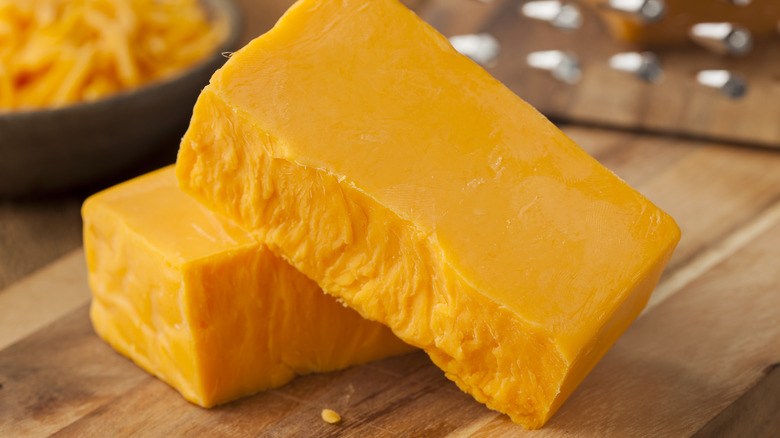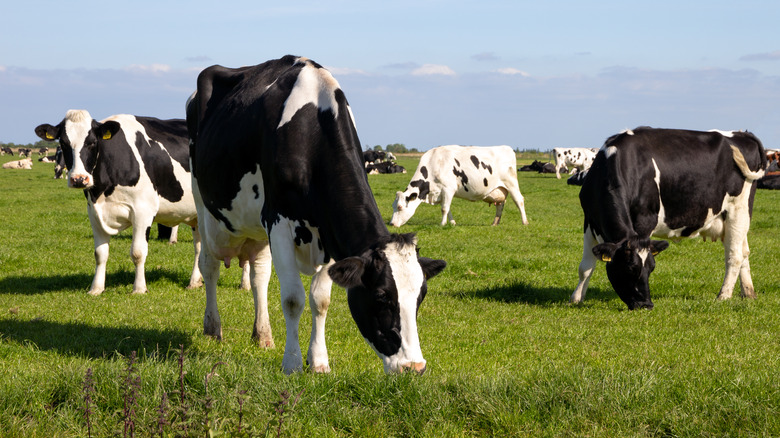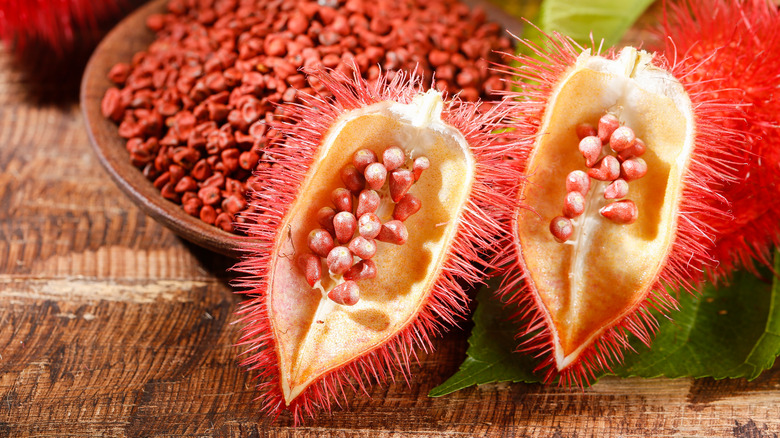The Way Cheddar Gets Its Color
Cheddar is a versatile, beloved cheese that makes for a tasty accompaniment to grilled cheese sandwiches, mac 'n' cheese, charcuterie boards, and so many other dishes. If you're like most people, you're too busy enjoying America's most popular cheese to really consider where it gets its distinctive look. The YouGov poll that crowned cheddar king of cheeses has American and mozzarella occupying second and third place, respectively. While delicious, these cheeses have a much subtler taste compared to the tangy, bright flavor synonymous with cheddar.
Cheddar also offers cheese lovers a ton of variety, including mild, sharp, and extra sharp types. According to Wisconsin Cheese, the aging process has a big impact on the flavor of cheddar. Mild cheese is aged for the shortest period, with a minimum of three months and a maximum of six months. Sharp varieties are allowed to age a bit longer, typically from nine to 12 months. The tongue-puckering tang of extra sharp cheddar comes from an extended aging process, which can last as long as two years. While it has a major effect on flavor, the aging process does not affect the coloring of cheddar. Instead, there are two key factors that influence the tell-tale orange hue of cheddar.
How a cow's diet influences color
The diet of the dairy cow producing the milk that makes cheese can influence coloring, specifically when cows have a diet that includes a lot of grass. Grass contains beta-carotene, which according to Medical News Today is what gives vegetables like carrots and peppers their vibrant coloring. The Office for Science and Society explains that milk is more likely to have a yellow hue when a cow's diet is primarily grass, as compared to cows that eat a lot of grain. Accordingly, any cheese that is made from the milk of grass-fed cows is also more likely to have an orangish-yellow coloring.
You may be wondering, "why is grass green if it contains an orange pigment?" Well, the answer lies in your old science textbooks. As explained by Live Science, grass also contains chlorophyll. In addition to the vital role it plays in photosynthesis, chlorophyll reflects green light wavelengths instead of absorbing them (like it does with red and blue wavelengths). That's why grass appears green to your eyes — it's the wavelength of light that chlorophyll reflects — but it still contains beta-carotene. Along with a cow's diet, cheesemakers also utilize another helpful trick to ensure their products look bright and enticing on grocery store shelves.
Why annatto is the secret ingredient to cheddar
For many people, cheddar's bright orange color indicates that plenty of cheesy goodness lies ahead. Because a grass-heavy diet can only add so much color, cheese manufacturers these days get a lot of help from the achiote tree. Healthline explains that in addition to being used as a seasoning, achiote seeds are integral in manufacturing annatto, a common natural food dye. Wisconsin Cheese clarifies that this food coloring is what gives your favorite cheddar cheeses their vibrant hue, above and beyond what can occur naturally based on the cow's diet.
According to Smithsonian Magazine, achiote seeds are a deep red color on their own. That means that the amount of annatto used during the cheesemaking process dictates the brightness of the final product. A small amount creates a pale-yellow cheese, but increasing the concentration results in a deep orange, almost red color. As for flavoring, Popular Science claims that annatto has no impact on how your favorite cheddar brands actually taste because so little of it is used. Per Healthline, the additive can have a sweet yet slightly tangy flavor profile when used as seasoning.


